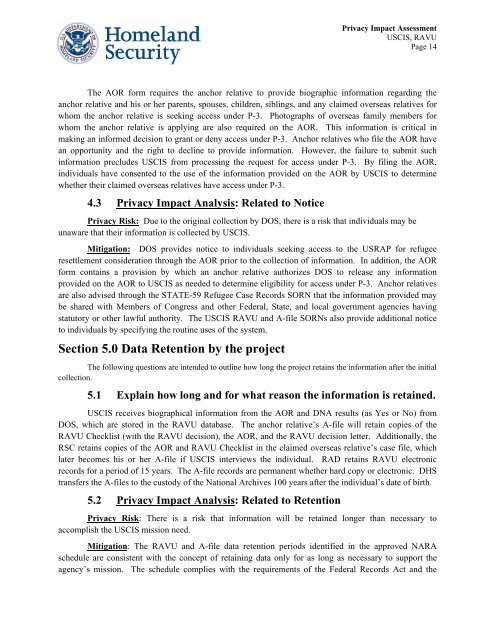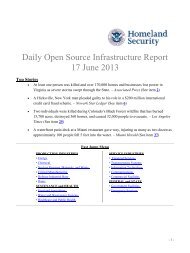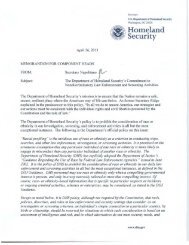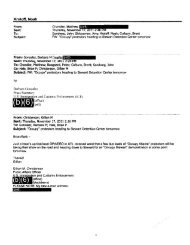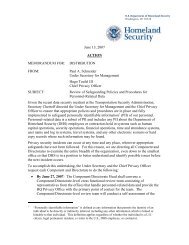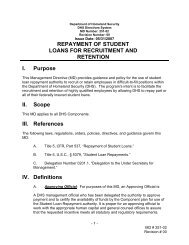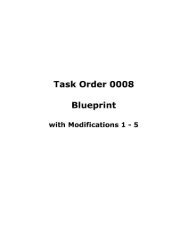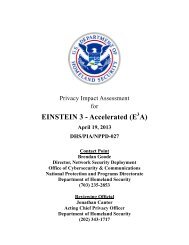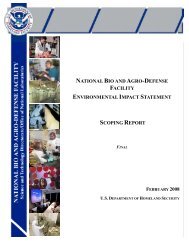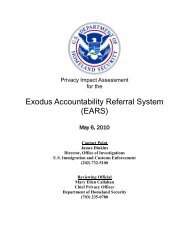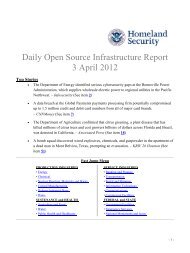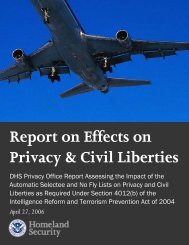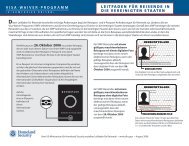RAVU - Homeland Security
RAVU - Homeland Security
RAVU - Homeland Security
You also want an ePaper? Increase the reach of your titles
YUMPU automatically turns print PDFs into web optimized ePapers that Google loves.
Privacy Impact AssessmentUSCIS, <strong>RAVU</strong>Page 14The AOR form requires the anchor relative to provide biographic information regarding theanchor relative and his or her parents, spouses, children, siblings, and any claimed overseas relatives forwhom the anchor relative is seeking access under P-3. Photographs of overseas family members forwhom the anchor relative is applying are also required on the AOR. This information is critical inmaking an informed decision to grant or deny access under P-3. Anchor relatives who file the AOR havean opportunity and the right to decline to provide information. However, the failure to submit suchinformation precludes USCIS from processing the request for access under P-3. By filing the AOR,individuals have consented to the use of the information provided on the AOR by USCIS to determinewhether their claimed overseas relatives have access under P-3.4.3 Privacy Impact Analysis: Related to NoticePrivacy Risk: Due to the original collection by DOS, there is a risk that individuals may beunaware that their information is collected by USCIS.Mitigation: DOS provides notice to individuals seeking access to the USRAP for refugeeresettlement consideration through the AOR prior to the collection of information. In addition, the AORform contains a provision by which an anchor relative authorizes DOS to release any informationprovided on the AOR to USCIS as needed to determine eligibility for access under P-3. Anchor relativesare also advised through the STATE-59 Refugee Case Records SORN that the information provided maybe shared with Members of Congress and other Federal, State, and local government agencies havingstatutory or other lawful authority. The USCIS <strong>RAVU</strong> and A-file SORNs also provide additional noticeto individuals by specifying the routine uses of the system.Section 5.0 Data Retention by the projectThe following questions are intended to outline how long the project retains the information after the initialcollection.5.1 Explain how long and for what reason the information is retained.USCIS receives biographical information from the AOR and DNA results (as Yes or No) fromDOS, which are stored in the <strong>RAVU</strong> database. The anchor relative’s A-file will retain copies of the<strong>RAVU</strong> Checklist (with the <strong>RAVU</strong> decision), the AOR, and the <strong>RAVU</strong> decision letter. Additionally, theRSC retains copies of the AOR and <strong>RAVU</strong> Checklist in the claimed overseas relative’s case file, whichlater becomes his or her A-file if USCIS interviews the individual. RAD retains <strong>RAVU</strong> electronicrecords for a period of 15 years. The A-file records are permanent whether hard copy or electronic. DHStransfers the A-files to the custody of the National Archives 100 years after the individual’s date of birth.5.2 Privacy Impact Analysis: Related to RetentionPrivacy Risk: There is a risk that information will be retained longer than necessary toaccomplish the USCIS mission need.Mitigation: The <strong>RAVU</strong> and A-file data retention periods identified in the approved NARAschedule are consistent with the concept of retaining data only for as long as necessary to support theagency’s mission. The schedule complies with the requirements of the Federal Records Act and the


